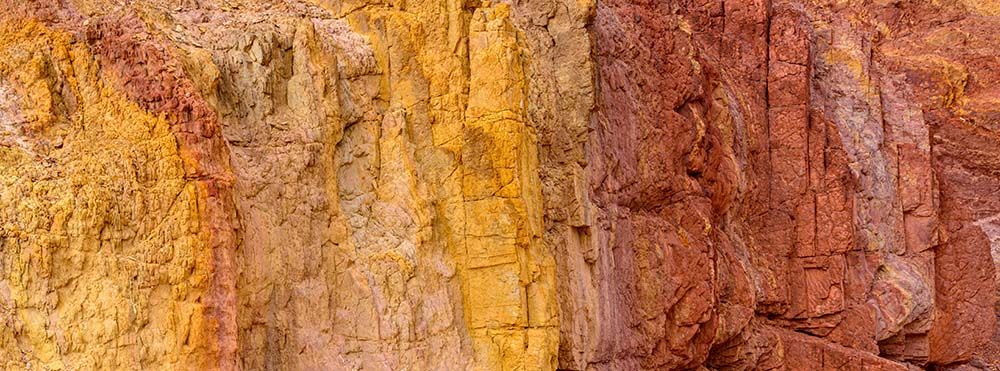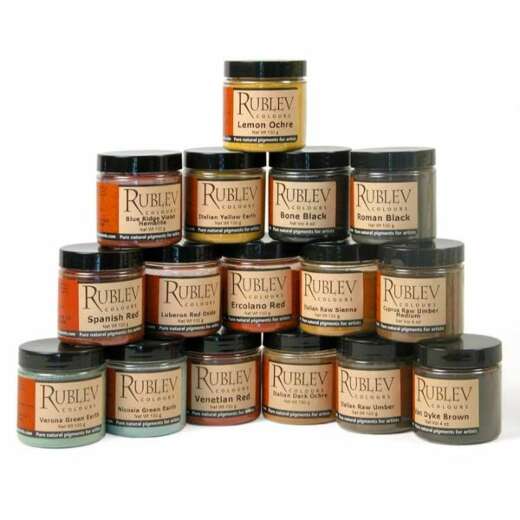
Natural iron oxide pigments or iron oxide earth pigments, collectively referred to as iron oxides, comprise both oxides and oxide hydroxides of iron. Hematite (α-Fe2O3) is the most common iron oxide in red earth pigments, and the iron oxide hydroxide goethite (α-FeOOH) is the most frequently found iron compound in yellow earth pigments. Umbers are brown earth pigments containing both oxides of iron and manganese.
Names for natural iron oxide pigments are complex and inconsistent. Yellow pigments based on iron oxide hydroxides are referred to by many names, including goethite, limonite, raw sienna, Mars yellow, yellow earth, yellow ocher, yellow iron oxide, yellow hydrated oxide, and iron hydroxide pigment. Similarly, natural red pigments based on anhydrous iron oxide are referred to as hematite, red earth, red ocher, burnt sienna, Mars red, and red iron oxide.
The problem is compounded further when manufacturers label synthetic iron oxide pigments with names typically associated only with earth pigments, such as a synthetic yellow iron oxide labeled yellow ocher.
Iron oxide pigment is an appropriate name for natural and synthetic materials that may contain mixtures of iron oxides and iron oxide hydroxides. The names earth and ocher are suitable when it is clear that the pigment comes from a natural source. Earth is a more general term since ocher refers to a specific type of iron oxide deposit containing kaolinite (clay) and quartz. Hematite is used to differentiate the crushing of mineral hematite, which contains a high proportion of iron oxide in a finely divided form and is usually associated with clay or other minerals. Umber refers to a chemically distinct class of brown earth pigment containing both manganese and iron oxides.
The Colour Index (1982, 1:16–17, 120–122, 64–65) lists natural red iron oxide pigments as CI Pigment Red 102 (nos. 77015, 77491, and 77538). Synthetic red iron oxide pigments are listed as CI Pigment Red 101 (nos. 77015, 77491, and 77538). The natural and synthetic yellow iron oxide pigments are listed as CI Pigment Yellow 43 and 42 (no. 77492), respectively. CI Pigment Brown 6 and 7 (nos. 77491, 77492, and 77499) designate synthetic and natural brown iron oxide pigments, including umber.
Generally, we can summarize the various iron oxide pigment names and their Colour Index designations as follows:
| Earth Pigment Types | Colour Index | Common Names |
| Yellow Earth Pigments | Pigment Yellow 43 | Limonite, goethite, jarosite, yellow ocher, yellow earth, raw sienna, yellow iron oxide |
| Red Earth Pigment | Pigment Red 102 | Hematite, red ocher, red earth, burnt sienna, red iron oxide |
| Brown Earth Pigments | Pigment Brown 7 | Pyrolusite, brown ocher, umber, burnt umber |
To determine whether a pigment is from a natural source, such as an earth iron oxide pigment, look for the Colour Index designation, such as Pigment Yellow 43 (PY43), Pigment Red 102 (PR102), or Pigment Brown 7 (PBr7).
The labels on paint tubes indicate whether they contain natural or synthetic pigments. The Colour Index Generic Name (CIGN) Pigment Yellow (PY 23) indicates natural raw sienna, while Pigment Red 102 (PR 102) indicates natural burnt sienna. Aspiring artists should be aware of these distinctions and choose their materials accordingly to achieve the desired effects in their artwork. The Colour Index for natural sienna can also be written as Pigment Brown 7 (PBr 7), as noted in Table 1 Suitable Pigment List of the ASTM D 4302 Standard Specification for Artists’ Oil, Resin-Oil, and Alkyd Paints.
| Color | Mineral | Chemical Formula | Structure | Crystal System |
| Yellow | Goethite | FeOOH | Ramsdellite / hcp oxygen | Orthorhombic |
| Akagneite | Hollandite/bcc oxygen | Tetragonal | ||
| Lepidocrocite | Boehmite / ccp oxygen | Orthorhombic | ||
| – | Cdl2 | Hexagonal | ||
| Red | Hematite | Fe2O3 | Corundum | Hexagonal |
| Maghemite | Defect spinel | Cubic | ||
| Black | Magnetite | Fe3O4 | Inverse spinel | Cubic |
Iron oxide occurs naturally in various forms and colors. Indeed, iron is the second most abundant element on Earth, representing over 5% of the Earth’s crust. These natural products tend to consist of coarse particles and contain impurities, making them appear less chromatic. The chemistry of iron is a very complex field where, under different natural geological conditions, several different crystal forms of the same compound, differing due to the arrangements of molecules within the unit cells of the crystalline lattice of each crystal form, are formed (see table above).
The different crystal forms and accessory minerals associated with each deposit of iron oxide earth create a nearly unlimited variety of color, texture, and rheological behavior when dispersed in paint. This variety gives artists ore choices of expression and is one of the main advantages of natural earth iron oxide pigments in art.













